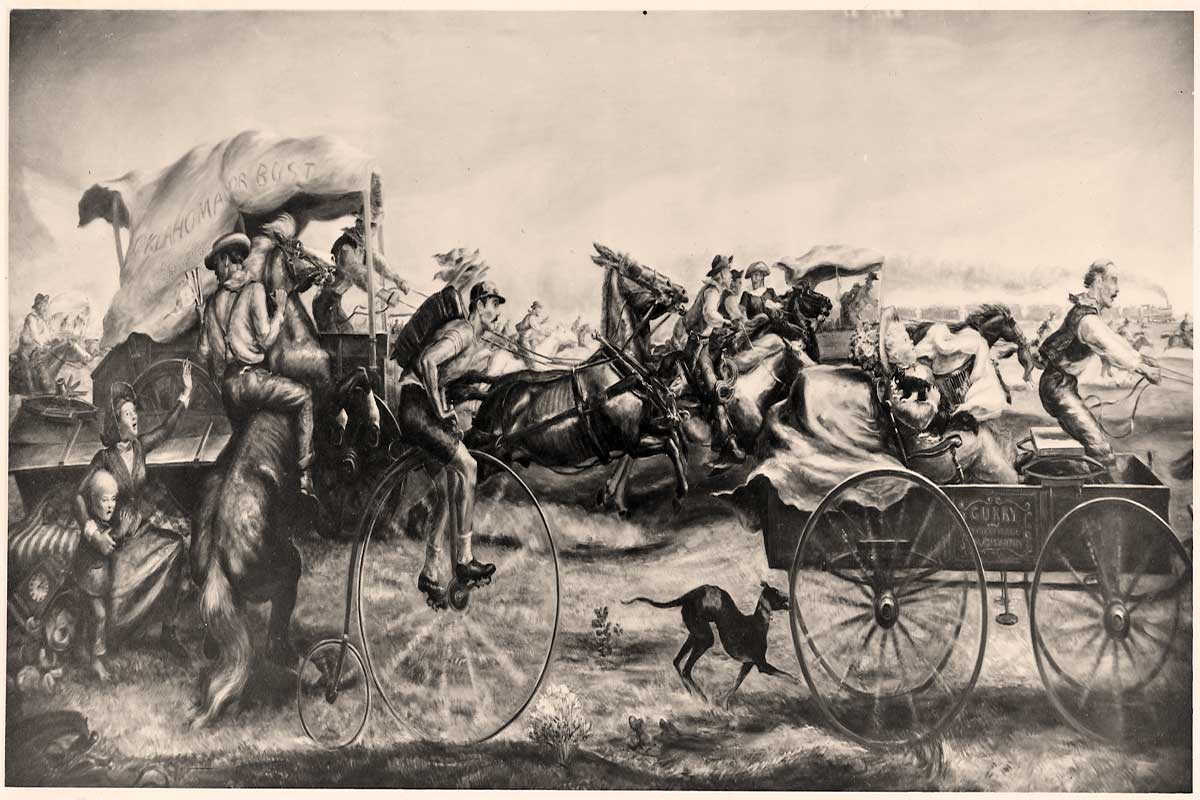
The date is April 22, 1889. It is five minutes till noon in central Oklahoma. The solid wall of horses, extending as far as the eye can see in either direction, bends and ripples restlessly, hooves pawing the ground and eye whites flashing. Their eagerness is mirrored in the faces of their riders and drivers, who sit in every kind of wagon, gig, and buckboard imaginable. Nearby, a train stands calm and stately, patiently puffing out small clouds of steam. Unlike the excitedly buzzing swarm of humanity crammed into the cattle cars, the imperturbable engineer awaits the signal, briefly reminding himself that he has been ordered not to exceed fifteen miles per hour so that the horses have a fair chance. About 10,000 settlers crowd along the line, and there are only some 1,100 homesteads available. At high noon, the race will be on….
The Boomers
For years, farmers, cattlemen, railroad companies, and a good number of government officials had been clamoring for the opening of the “unassigned” acreage used by the Indians as grazing land. A good many Americans simply refused to stay out of the forbidden territory, and every time troops escorted them out of Oklahoma, a perfect howl arose that the government was discriminating against “Boomers,” as those pushing for an opening were called.
The Rushes

At last both the Indians and the Federal government succumbed to the pressure. The unassigned lands were settled during the first land rush in 1889. But that was far from being the end of the call for more land. The would-be settlers next demanded that some of the reservations be opened. Another rush in 1891 populated the Iowa, Sac and Fox, and Pottawatomie-Shawnee lands with white men. Then followed the Cheyenne and Arapaho land in 1892, and Cherokee Outlet in 1893, the largest land run in U.S. history. The opening of the Kickapoo reservation in 1895 was Oklahoma’s last and smallest land run. Subsequent openings were made by lottery, in which prospective settlers registered to participate in a drawing. The first person whose name was drawn had the right to choose his homestead first, the second person drawn claimed a homestead next, and so on.
The Sooners
Opening reservations by lottery instead of by land rush brought some sanity to the procedure. During a land rush, many people, known as “Sooners,” didn’t have the patience to wait for the signal to start and entered Indian Territory ahead of time to ensure themselves a claim. They often hid out until the rush began, then appeared on the scene to drive away the lawful settlers. Men who worked for the government were particularly bold about staking claims early, since they did have the right to be in the territory. The most notorious of these “legal Sooners” were the U.S. marshals and their deputies.
The Indians
In spite of all the promises made to the Indians that their lands would belong to them forever, towns full of white men sprang up overnight throughout the land rush era. Indian Territory, once covering almost all of modern-day Oklahoma, quickly dwindled to only the eastern half of the region, while the western half became known as Oklahoma Territory. In one last effort to save their property, the Indians requested admission to the Union as the State of Sequoyah, but eastern politicians refused to have two new western states, especially if one was populated by Indians. Both Indian Territory and Oklahoma Territory were combined into one. Oklahoma gained admission as the 46th state in the Union on November 16, 1907.
Further Investigation
Rushes to Statehood: The Oklahoma Land Runs
Information about each land run with maps, photos, and links to further reading.
Starting Line of the First Oklahoma Land Rush
Photo of the April 22, 1889, event.
Land Run of 1889
Background info and pictures from the Oklahoma Historical Society.
Cherokee Outlet Opening
Background info and pictures of the 1893 land run from the Oklahoma Historical Society.
The Oklahoma Land Rush of 1893
From an eyewitness account.
Activities
Make a Compass Activity
“Those who made the land run often carried compasses to ensure they traveled in the desired direction.” Directions for making two different types of compasses from the Oklahoma Historical Society.
You Are There: The Oklahoma Land Run
Old radio show reenactment.
Books

The Oklahoma Land Run by Una Belle Townsend
Recommended historical fiction title about a young boy driving the family’s wagon during the April 22, 1889, land run.
Unit Studies & Lesson Plans
Primary Source Activity: The Oklahoma Land Rush
Lesson plan using primary source activities to learn about the land rush that includes discussion questions and graphic organizers.
Stepping Into the Oklahoma Land Run
4-H lesson plan that includes discussion questions, math activities, research activity, map work and a DIY land run.
The Oklahoma Land Run
17-page activity book from the Oklahoma History Center.
Printables & Notebooking Pages
Oklahoma Land Openings
Map showing the different areas of land in Oklahoma that were made available to settlers. Perfect for notebook.
Oklahoma Land Rush Notebooking Pages
Simple notebooking pages for copywork, narrations, or wrapping up.
Ready for More?











You must be logged in to post a comment.